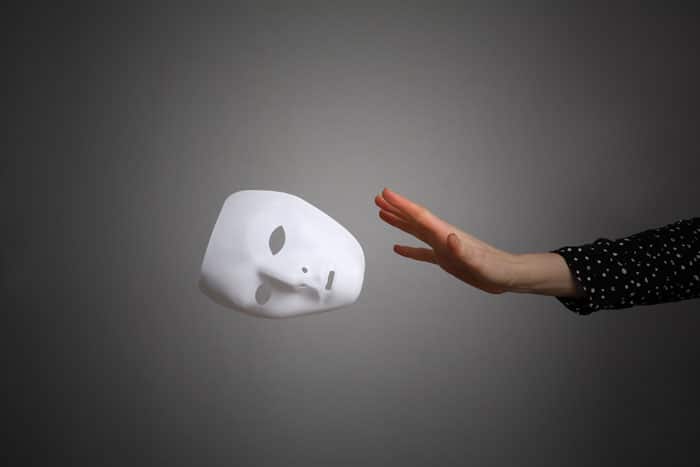
Two years. It’s been two years since we’ve seen an UnMasked World. Two years of children breathing their own imperfectly brushed tooth-smells, two years of N95 synthetic creating a layer of “mascne” (mask induced acne) on our mien. For two years we have been shut out of stores without our masks on, told by formerly close friends that we are no longer inner-circle by their eyes only, and messaged by the world that something dreadful, indeed lethal, might happen to us UnMasked. Our voices and freedoms have been muffled and muted beneath layers of filters and fear.
With mask mandates being repealed across the country, what lies beneath these UnMasked Times leaves our baby-soft skinned mouths agape: refugees fleeing a European country, the threat of nuclear accident (or purposeful attack), and the daily montage of gruesome images out of Ukraine reminiscent of Vietnam-era photojournalism. It seems that the world itself has UnMasked, revealing the ugliness that has brewed beneath our breathlessness for two years: the reboot of an existential threat to democracy and the urgency, more than ever, to protect it.
It seems that the world itself has UnMasked, revealing the ugliness that has brewed beneath our breathlessness for two years: the reboot of an existential threat to democracy and the urgency, more than ever, to protect it.
As each of us discerns exactly when and where we will UnMask, an urgent question arises alongside the Purim reading of the Megillat Esther: How does the Great UnMasking transform into the Great Jewish Reveal?
This year, a confluence of occurrences in time, like a cosmic event of an eclipse or comet visitation in space, occur together around Purim: Our end-of-winter festival aligns a few days before the beginning of Spring. The days following Purim are the start to Daylight Savings Time, literally a harbinger of extended light in our life. As a shmitah year, our end-of-winter festival has an amplified sense of release and renewal. And if that weren’t enough, we are hovering between two Purims this year, as it is a leap year—Adar Alef and Adar Bet, as the Jewish leap year adds an extra month to our calendar. Indeed, our time, our light, yes, our lives, are expanding at hyper warp speed.
The Megillah’s shadows also loom greatly upon our landscape: Putin wears the Haman mask as the bloodshed of the ninth chapter is happening in real time with war exploding in Ukraine.
However, the Megillah’s shadows also loom greatly upon our landscape: Putin wears the Haman mask as the bloodshed of the ninth chapter is happening in real time with war exploding in Ukraine. And as our nation passes the one million mark of COVID deaths any day now, what expression of Purim should be “celebrated”? What significance do we find in the mitzvah of “joy” while we also recognize the anniversary of the two-year mark of COVID times earlier that week, a time when we were introduced to the world of isolation, hand sanitizer, lock downs, quarantine, Zoom, and masks. How might our ancient tale of light and darkness bear significance to all we have lost or borne witness to?
And, in the face of all of these woes, how do we, like Esther herself, reveal ourselves to the world as individuals transformed by all that we have been through? Are we prepared to take a stand in a world where God indeed seems hidden? This Purim, how do we, once and for all, UnMask as Jews?
Purim—Awareness of Reversals
Purim is a topsy-turvy holiday. This idea is taken so literally that JT Waldman, the clever artist/author of a graphic novel, “Megillat Esther” (JPS, 2005), required the reader to turn the book upside down in order to complete the second half. Throughout Megillat Esther and the rabbinic discussions about it, the idea of “hithafchut” or reversal, spotlights the vertiginous experience of our observance. In addition to the commandment to get so drunk as not to be able to distinguish between Haman and Mordecai, the preponderance of these literary reversals reads like spinning teacups—a scroll within a scroll.
In the face of all of these woes, how do we, like Esther herself, reveal ourselves to the world as individuals transformed by all that we have been through?
The story begins with a description of time and place in a kingdom that extends far and wide “From Hodu to Cush,” only to be amended in b. Megillah 11a so that “Hodu and Cush are next to each other.” The Book itself, called Esther, is about a woman whose name was Hadassah, but who was renamed as the Babylonian Goddess of Love Esther, also known as a cognate of the ancient near-eastern goddess Isthar scribed in the Enumah Elish. Sent by Mordecai (or Marduk, a likening from the same Babylonean myth), Esther is all at once, Mordecai’s niece, cousin, adopted daughter and even his wife. Esther is both a “bitulah” (virgin) and the most beautiful woman ever created, so that even at 80 years old (Genesis Rabbah 39:13), she aroused the interest of the king more than all of the other virgins in the land. The name Esther itself suggests something more ominous in the book, as the letters of the name bear a theological message about the presence of God through dark times: alef, a symbol of God in rabbinic tradition, is followed by the letters samech, tav and reish, the root for the word “hidden,” as it is the only book in the Bible in which God is not mentioned. In a troubled world where God did not show up, our ancient scribes chose to inform us, Esther literally (and literarily) did.
And the reversals continue in the most embodied way: Purim is the gender-bending holiday, where the prohibition from Deuteronomy 22:5 — “There shall be no man’s item on a woman, and a man shall not wear a woman’s garment, for anyone who does these things is abhorrent to YHWH your God” — is not valid. In a Teshuvah (Judah Minz, Padua, 1509) it is stated that “with regard to the custom of wearing a parsufim (mask) whereby a man dresses himself in the garment of a woman and a woman puts on the attire of a man, it is not forbidden.” The collection of reversals and switchbacks in the Megillah itself grants primacy to the gender-bending land of queer sarisim (eunuchs) who “guard the harem” and are themselves agents of plot twists in the text.
Perhaps more than ever in our lifetime, Purim resembles the world we UnMask into today, capturing the dramatic tension of our time. From non-binary eunuchs who administer makeup to the harem-like “RuPaul’s Drag Race,” to the efforts of the descendant of Amalek (Haman) to plot our ultimate demise—Purim plays out like a Jewish horror play, a brutal tale (just read Chapter 9!) of the forces of light and darkness, good and evil, revenge and ascension. What does it mean in our modern expression of the holiday that our Megillah story is glorified as a celebration for children in a retelling of the story as a dissimulated Shushan-style Disneyland, complete with ball gowns and tiaras? Perhaps this is just another reversal, or perhaps a conditioning—an intentional onboarding for young children into the cruelty of the world around us. At its essence, Purim illuminates the path ahead for how to navigate through our own experience of diabolical antagonists presenting existential threats to a Jewish community that has already experienced too much. As we consider our Purim costume this year, perhaps the most essential one of all might be the one that UnMasks the story and bears its true essence.
The Origins of Masks
Purim holds a unique place in the Jewish canon, a literal “historic event”: Where Torah commands holidays “by God,” Purim reverse engineers a new holiday in this image, as the Purim celebration is uniquely commanded not by God, but by humans. With this in mind, what is the implication of this year’s observance? If the story itself is a human-crafted celebration, what other imperatives around this year’s observance might we glean? This year, how must we make Purim different?
The Hebrew words for mask, “parsuf,” has preference over “massekhah” as the latter is associated with graven images. Parsuf was used for the first time to describe one wearing a costume with a face covering for a masquerade in the 16th century, an historic déjà vu when war in central Europe and persecution in Ukraine has removed a sense of ease and confidence in Jewish gathering. Derived from the Italian commedia dell’arte, the masks first resembled stock characters from a traveling minstrel: Zanni (servants, clowns in our tale), Vecchi (the wealthy old man; here, Mordecai), Innamorati (the beautiful maidens, or Esther) and Il Capitano (the braggart “man in command,” here a buffoon of a king, Ahausueros). The commedia did not spotlight a character of pure evil, as it sought to achieve levity and lightness; perhaps, for Jews, our addition of Haman in costume, dressed in triangular hat and black mask, was as much inspired by the times besmirched by pogroms and persecution as the story itself.
However, masking itself was historically a controversial subject. Jewish law switches between laws prohibiting masks (which would “inhibit moral behavior”) and permissive pursuits of mask-wearing merriment. In essence, the parsuf represents how people in different times and places expressed concerns and interests around persecution, dissimulation, and what we might even invite Karl Jung to call “The Shadow”—an unconscious aspect of our personality of which we are not fully conscious. With the plasticity of the history of masking in mind, what role does the mask take on for us as we face Purim, 5782?
The Great Unmasking
This year, Purim arrives the same week that the State of California changes its masking recommendations.
This year, Purim arrives the same week that the State of California changes its masking recommendations: “With declining case rates and hospitalizations across the West, California, Oregon and Washington are moving together to update their masking guidance. After 11:59 p.m. on March 11, California, Oregon and Washington will adopt new indoor mask policies and move from mask requirements to mask recommendations in schools” (gov.ca.gov, 2/28/22). With our most vulnerable being invited to finally, after two long-lost years, take off their masks, we must consider the true question hovering among us: Are the adults ready? The only way that “The Great UnMasking” can occur is if the adults do the work that is required to succeed in this perhaps greatest of all reversals. We will need the courage of Esther, the humility of Mordecai and the faith in a God in hiding to get through it.
The Great UnMasking of 5782 requires us to take personal responsibility for ourselves. It asks us to do more than accept that when we finally take down our masks, our teeth may reveal a yellowing, as dental appointments for cleaning are hard to come by. Our smiles will be shy as the hearts engineering them have lingering suspicion toward the stranger with questions like: “Will our ultimate demise come from a friend whom I haven’t seen in two years?” and “How will I deal with the fact that he spits when he talks?”
When we let down our masks, we must also let down our judgements. We must lay down the staffs of our own imperial rule and grant entry to others —other ways of living, other life choices, other ways of seeing.
When we let down our masks, we must also let down our judgements. We must lay down the staffs of our own imperial rule and grant entry to others — other ways of living, other life choices, other ways of seeing. Like Esther, we must all recognize that all of us are the other. All of our ways will be foreign to others and all of our mouths potential weapons of mass destruction. The Great UnMasking of Purim 5782 demands that instead of meeting difference with judgement, we must exercise our flaccid compassion muscles — muscles that thrive in crowded subways, hushed movie theaters when someone has a cough, bustling restaurants on a rainy day during lunch time when the person next to us sneezes. We must release our prejudices or assumptions that we know science better than others, and instead learn to trust that the other is looking out for us as we are looking out for them. We must move from our Comedy of Terrors to a Comedy of Errors and find forgiveness and even humor in the many malapropisms awaiting a culture out of practice doing culture together.

In his own “Great Unmasking” last year in The New York Times, David Brooks, perhaps prematurely, wrote that “The Great Unmasking asks ‘What’s really important, and how should I focus on what matters?’” He continues: “People wear masks when they feel unsafe, and for more than a year, we were unsafe, and we had to wear masks. But the physical masks we wore were layered on top of all the psychological masks we had put on, out of fear, in the years before COVID.” Now at two years, and with war in Europe, how much more terror hides behind our N95s?
A Topsy Turvy Future
With the world burning around us, pandemic not abating, and climate change the next existential threat just around the corner, Purim’s unique place as “the only holiday celebrated in the world to come,” may feel, uncomfortably, closer than ever. And yet, perhaps we are evolving as a civilization conditioned to meet the highest call ever known to global humanity—a call for a world-wide repentance. As Mordecai took to sack-clothes upon the news of Haman’s plot to destroy the Jews, might we turn our own hearts and employ all of our power and understanding to truly embody what is asked of us at this time? What would a world-wide unmasking filled with soul-searching repentance look like?
Rabbi Avraham Sutton, the Rabbi of the Carlebach Shul on the Upper West Side, in his book, “Purim Light: The Reality of G-d in Our Lives,” writes:
“[In the Megillat Esther,] the Divine soul is forced to leave its place in ‘heaven’ and descend into a world where ‘heaven’ is completely hidden. Only there can the soul ‘go to itself,’ i.e., realize its own potential. The only catch is that it might initially fall into a state of amnesia in which it temporarily forgets its higher self, who it really is. But precisely in such a stage of exile will it be forced to draw upon its deepest reservoirs of holiness and transform not only its physical vehicle but the entire world around it into a stage for the revelation of G-d’s presence.”
What would a world-wide unmasking filled with soul-searching repentance look like?
In Chapter 5 of Megillat Esther, Mordecai addresses Esther with the same missive more directly: “Do not imagine that you will be able to escape in the King’s palace any more than the rest of the Jews. For if you persist in keeping silent at a time like this, relief and deliverance will come to the Jews from some other place, while you and your father’s house will perish. And who knows whether it was just for such a time as this that you attained a royal position!”
As apocalypse means “uncovering” in Greek, perhaps our path to redemption requires us, like Esther, to face our most essential truth: American Jews (like Esther in Shushan, living like royals in the Diaspora) must hit the amnesiac alarm clock, UnMask from our assimilated veneers, and rise to the call of Jewish spiritual transformation leaning into our core values of justice, love, compassion, grace and truth.
COVID times already prepared us for what comes next. It has already revealed our truest colors—triggers of mandates, political schisms, isolation, loss, loneliness, health challenges and more demanded that each of us face our own truths within the walls of our homes, and begin to practice self-improvement and self-knowing. Now, as we collectively hear the air raid sirens wail across the land on Purim, 5782 — from Ukraine to the United States and Alaska to Argentina — as bombs crashing into kindergartens explode in Europe, and ear-piercing tones induce headaches in hospitals as COVID patients code; as our children gather into storage closets while they practice “active shooter preparedness” in schools, and as the rabbi throws a chair at an intruder; as the media irresponsibly tears at the frayed seams of our country’s divide, and as the CO2 clock is about to blare with a reckoning that makes a pandemic look like a dress-rehearsal, perhaps the time has finally come. Perhaps, on the morning of Purim, 5782 when our alarm clocks go off we will recognize them as groggers in our modern world, a call to smite out evil once and for all, beginning with each of our broken, tender souls, and to turn, with fear and trembling, and face this momentous turning point: the moment when all of us will, once and for all, take off our masks and stand as Jews as a face-off to the world’s moral ambiguity and existential impermanence. As Jews, we have over 3000 years of knowing how to handle war; we are resilient. We know how to respond to a graven images of destruction — we mourn and find meaning. We’ve got Mordecai and Esther in our back pockets, a leader in Ukraine unafraid to speak truth to power, and the Great UnMasking to unmuffle and amplify our voice. This Purim, find yours.
Rabbi Lori Shapiro is the founder and artistic director of The Open Temple in Venice.





















 More news and opinions than at a Shabbat dinner, right in your inbox.
More news and opinions than at a Shabbat dinner, right in your inbox.